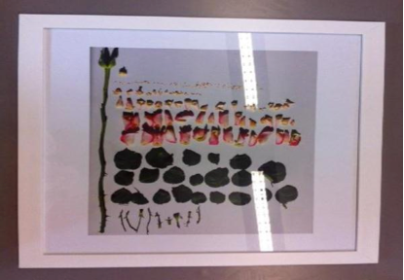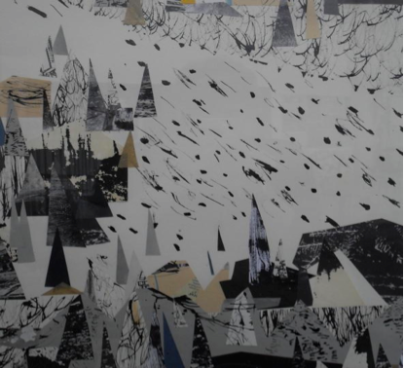63 exhibitors in one gallery in all mediums, was going to be a hard circle to square, so I approached the final hang of Conglomeration with some trepidation. Was it going to be a hotchpotch of things thrown together with little or no coherence or was it going to be a feast for the senses? My fears were not bourne out. Some neat and intelligent curation meant that the space didn’t look cluttered or over full. The placing of the works led the viewer quite naturally from one space to another with strategically placed works designed to make the bridge or segue from one zone to the next, so for example Dan Gregory’s work led the eye and direction of travel round the corner from right to left and Gregory Hayman’s work did the same at another key junction. Work was placed on the floor, wall, ceiling, used plinths, film and sound and all making optimum use of the tricky lighting scheme in the Stew Gallery.
One of the highlights of the show was Hannah Satchwell’s floating shirt sculpture. Suspended from the ceiling by near invisible cat gut, the piece seemed to hover in the middle of one of the gallery spaces, defying gravity and providing a mesmerising centre piece for the area. It’s economy, and the height at which it hung (below waist height) made it disturbing and unsettling and it dominated its space to magnificent effect. Gabriel Loy’s Mosaic, a large colour print of out of focus coloured forms, had echoes of stained glass and was strangely hypnotic. It also had a feel of an Andreas Gursky photograph with the quality of lighting and the bold colours. It had that beguiling quality, at once both figurative and then an abstract mosaic of colour and texture drawing the viewer in.
Grace McAlonan’s photograph at first glance looked like an abstract collection of shapes and colours arranged on the page. Closer inspection however revealed that they were the constituent parts of a dismantled rose. The clever and disturbing take on the memento mori was beautiful and arresting and quite rightly has resulted in a number of potential purchasers wanting copies. The piece was a natural development from her previous work with vegetable and natural forms presented in series. This piece however, was a significant leap forward and was beautiful and mournful at the same time illustrating the transitory nature of love and beauty and breaking it down into a taxonomic collection of parts.
Mariane Lister-O’Shea’s Doe oh Dear, a mixed media on two canvases featuring a stag’s head and neck on one and a doe’s on the other was a powerful mix of the abstract and the figurative. The backgrounds of both were painted grids of simple colour (browns) making a landscape without sympathy and horizon or perspective. The two heads were black on white flattened images on paper and laid over the background one coming from right to left from the frame and the other the opposite (left to right) together this diptych was both a parody of the hunting genre al a ‘Monarch of the Glen’ and religious icon but any suggestion of the bambi-fication neutralised by the references to hunting trophy.
Robyn Smith
Title: 生存戦略.
The abstract shapes on four pieces of paper mounted together by Robyn Smith developed her use of abstract motifs and used a single emblem, for me the most powerful of her marks and one that closely resembles the Laban dance notation method for capturing choreography. Was this conscious or accidental? The piece did not reveal. The title: 生存戦略The survival, slightly, from the Chinese does not shed further light but that is immaterial, although the viewer is left to guess why the piece has a title in Chinese characters with no translation.
Abigail Softley’s collage of triangular shapes and mark-making formed an abstract landscape which brought to mind details from a Bruegel painting, particularly Hunters in the Snow, on the one hand or a Lowry on the other. The piece had clear pattern and balance, being perfectly resolved from a compositional point of view. The links may have been accidental but the visual chemistry to the observer are none-the-less implicit if you look at the two images below. The question has to be asked of some art works as to how conscious or unconscious are the art historical references? Images are absorbed and committed to memory in both conscious and unconscious ways and retrieved or revisited in any number of ways. But, maybe references are in the eye of the beholder… This is not to suggest that the work is in any way diminished by the explicit or implicit referencing, just that we store many images and it may be a deliberate and conscious choice by an artist or, if we follow the Barthes argument, then it is the viewer that completes the work and by implication sees their own references in a work, whether they were intended by the artist or not.
Gregory Hayman, Jubliee
Finally, I come to the piece Jubilee by Gregory Hayman. An explicit reference to the work of Robert Gober, and an iconoclastic take on the iconography of monarchy which seeks to cast the queen as a chess piece at best and a two-dimensional character at worst. The piece dominates a partial corner with gloomy malevolence. The queen looking out over her domain, wistful and glum, her chest pierced and revealing an opening that shows a hose which connects to the rear like some perverse tracheotomy, is it ventilating the patient or giving vent to the artist’s splenic views of the monarchy? We are not enlightened. Suffice to say that the hose makes it exit via an horse’s rear! The prints are monochrome and made on found plastic banners whose purpose is obscured by the broken words of Jub and ilee to make the reference, but does this broken lettering also reference an opinion about the broken state of the nation the queen rules over or her broken reign? It’s a piece littered with references and meaning and maybe double meaning or maybe that is the viewer completing the piece and not the intention of the artist at all.






